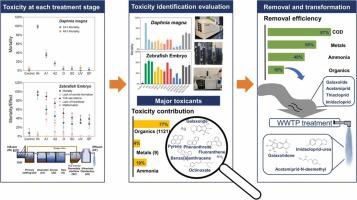Journal of Hazardous Materials ( IF 12.2 ) Pub Date : 2022-06-20 , DOI: 10.1016/j.jhazmat.2022.129426 Yuan Liu 1 , Faxu Li 1 , Huizhen Li 1 , Yujun Tong 1 , Weizong Li 1 , Jingjing Xiong 2 , Jing You 1

|
Municipal wastewater contains numerous chemicals and transformation products with highly diverse physiochemical properties and intrinsic toxicity; thus, it is imperative but challenging to identify major toxicants. Herein, toxicity identification evaluation (TIE) was applied to identify major toxicants in a typical municipal wastewater treatment plant (WWTP). Impacts of chemical properties on the removal of contaminants and toxicity at individual treatment stages were also examined. The WWTP influent caused 100% death of Daphnia magna and zebrafish embryos, and toxicity characterization suggested that organics, metals, and volatiles all contributed to the toxicity. Toxicity identification based on 189 target and approximately one-thousand suspect chemicals showed that toxicity contributions of organic contaminants, metals, and ammonia to D. magna were 77%, 4%, and 19%, respectively. Galaxolide, pyrene, phenanthrene, benzo[a]anthracene, fluoranthene, octinoxate, silver, and ammonia were identified as potential toxicants. Comparatively, the detected transformation products elicited lower toxicity than their respective parent contaminants. In contrast, the analyzed contaminants showed negligible contributions to the toxicity of zebrafish embryos. Removal efficiencies of these toxicants in WWTP were highly related to their hydrophobicity. Diverse transformation and removal efficiencies of contaminants in WWTPs may influence the chemical compositions in effluent and ultimately the risk to aquatic organisms in the receiving waterways.
中文翻译:

基于生物测定的城市废水中目标和可疑有毒物质的识别和去除:化学性质和转化的影响
城市废水含有大量化学物质和转化产物,具有高度多样化的物理化学性质和内在毒性;因此,确定主要毒物势在必行,但具有挑战性。在此,毒性鉴定评估 (TIE) 用于鉴定典型城市污水处理厂 (WWTP) 中的主要毒物。还检查了化学性质对各个处理阶段去除污染物和毒性的影响。污水处理厂进水造成大型蚤100%死亡和斑马鱼胚胎,毒性表征表明有机物、金属和挥发物都促成了毒性。基于 189 个目标和大约一千种可疑化学品的毒性鉴定表明,有机污染物、金属和氨对D. magna的毒性贡献分别为 77%、4% 和 19%。Galaxolide、芘、菲、苯并[ a]蒽、荧蒽、辛氧酸盐、银和氨被确定为潜在的有毒物质。相比之下,检测到的转化产物的毒性低于其各自的母体污染物。相比之下,分析的污染物对斑马鱼胚胎的毒性影响微乎其微。污水处理厂中这些有毒物质的去除效率与其疏水性高度相关。污水处理厂中污染物的不同转化和去除效率可能会影响出水中的化学成分,并最终影响受纳水道中水生生物的风险。











































 京公网安备 11010802027423号
京公网安备 11010802027423号